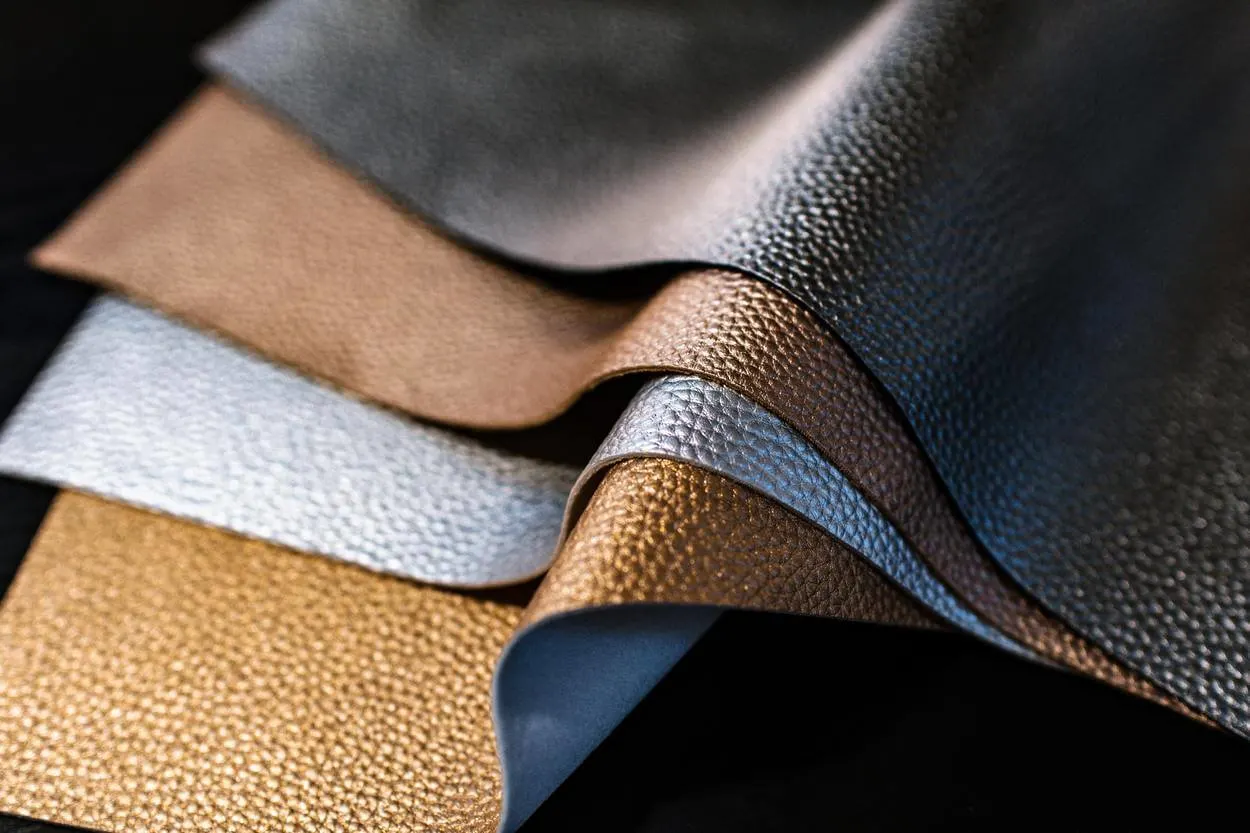It’s normal to eat meat, but vegans don’t like to consume animals. The same goes with choosing leather goods. May it be food, clothes, or furniture. Vegans love animal-free products. That’s why they prefer vegan leathers, such as polyurethane (PU) leather.
Although there’s an interesting fact about PU leathers, not all of them are animal-free. Bicast leather is an example. If you’re vegan, avoid it since it’s just covered in polyurethane but still contains animal skin.
Leather can spark your curiosity. From how genuine leather gets better over time to its numerous processes, types, and uses. You’ll be delighted to finish this article.
So buckle up, and get ready to be filled with knowledge about leather!
What Is Leather?
Leather is a textile made from animal skin (hide) produced through tanning — turning animal skin into leather. These animal skins come from numerous animals, such as sheep, crocodiles, and goats. However, cows are the most commonly used hide for leather.
What’s the Difference between PU and Real Leather?
PU leather is faux leather, while natural materials make genuine leather. You need synthetic materials to create PU leather. It’s animal-free, unlike genuine leather.
Sniffing also determines whether it’s a PU or real leather. If it smells like chemicals, it’s PU leather. This characteristic of PU leather is why some people still prefer natural leather. It has this distinct smell that faux leather, like PU, can’t emulate.
Pros and Cons of PU and Real Leather
It’s all about preference. There’s a reason why some people prefer PU leather, while some choose real ones. Remember, both have their advantages and disadvantages.
Pros of PU Leather
- Affordable
- Waterproof
- UV Resistant
Cons of Pu Leather:
- Doesn’t Age Well
- Not Breathable
Pros of Real Leather
- Durable
- Comfortable
- Hypoallergenic
Cons of Real Leather
- Not Animal-Friendly
- Causes Deforestation

Here’s What You Need to Know About PU and Real Leather
Real Leather Is Worth the Price
Genuine leather costs a lot, but it’s better for the long haul. Its quality improves as time passes by. That’s why some people choose genuine leather over faux ones. Patina is the reason leather quality improves leather quality. The more it ages, the more it gets better. It’s just like wine.
Real Leather Requires Tanning
Since real leather comes from animal skins, it needs tanning — the process of treating animal skins to create leather. It’s essential as it prevents the leather from rotting. There are two different ways of tanning: Vegetable and chromium tanning.
A general rule of thumb for understanding their difference is the process and its efficiency. Vegetable tanning is a natural process, but it takes time to produce. On the other hand, Chromium tanning uses acids and chemicals throughout the process. However, this type of tanning is prevalent since it’s faster and cheaper in production.
Real Leather Smells Good Because of Tanning
The pleasant scent of real leather is the by-product of tanning too! It comes explicitly from vegetable tanning. You’ll love to sniff the genuine leather’s odor. Not until it starts to emit a foul smell. Don’t worry. There’s a solution to this smelly problem.
Use baking soda for real leather, but be careful as it’s an abrasive cleaner. Some recommend using leather cleaning products instead to be safe. Although it’s worth noting that some may not have one at home. If you’re going to use baking soda for leather goods, add small amounts and mix them with water to prevent damages.
If you want to clean a leather jacket, this video is perfect for you:
PU Leather Isn’t Always Vegan
PU leather is considered vegan since it’s mostly 100% made with synthetic material, but be careful since some PU leather contains animal skin. An example is bicast leather. Polyurethane covers the animal skin’s remaining bottom layer, split into different layers.
Identify whether PU leather is 100% synthetic by looking at the label. Another way is to smell it. Remember, PU leather will always smell like chemicals.
If you’re looking for eco-friendly vegan leathers, here are some examples:
- Cork Leather
- Pineapple Leather
- Banana Leather
- Lino Leather
- Leaf Leather
PU Leather Uses Petroleum
During the manufacturing process, petroleum and various chemicals are included. This process harms the planet. Luckily, there are other ways to manufacture PU leathers. Water-based PU leather is an excellent alternative as its operation is toxic-free.
PU Leather Is Made Up of Thermoplastic Polymer
PU leather is made up of thermoplastic polymer because it’s easily molded into various shapes. This material is crucial to know as we benefit from thermoplastic polymer. It’s prevalent. Not only is it for PU leather, but it’s also for pipes, food containers, and the like.
Six Common Types of Real Leather
| Name of Real Leather | What Is It? | Is It Expensive? |
| Full-Grain Leather | An unaltered thick leather that contains all of its natural grain. | Yes, it’s the most expensive type of leather. |
| Top-Grain Leather | A commonly used leather without an outermost layer, removing imperfections that makes it thinner. | Yes, but it’s less expensive than full-grain leather. |
| Corrected-Grain Leather | An altered leather improves its qualities and appearance, such as imprinting an artificial grain. | No, it’s offered cheaper with similar durability to higher-grade leathers. |
| Split Leather | Made from an animal skin’s bottom layer and typically used for suede. | No, it’s more affordable than higher-grade leathers. |
| Genuine Leather | It’s considered the lowest quality of all real leather because it uses leftover materials from higher-grade leathers. | No, it’s one of the cheapest leathers you can buy. |
| Bonded (or Reconstituted) Leather | The mixture of real and faux leather. | No, it’s the cheapest as it only contains a bit of real leather. |
Two Main Types of Faux Leather
| Name of Faux Leather | What Is It Made of? | Is It Expensive? |
| PU Leather | Polyurethane | No |
| PVC Leather | Polyvinyl Chloride | No |
Final Thoughts
The main difference between PU and real leather is their materials. Synthetic materials produce PU leathers, while animal skins generate real leathers. Both types of leather have their pros and cons. PU leather is affordable, but some people are willing to pay more for real leather due to its patina that PU leather can’t copy.
If you’re a vegan, be cautious when buying PU leather. Bicast leather is covered by polyurethane, but it’s combined with animal skin. Avoid this problem by identifying whether PU leather is made with 100% synthetic material or not.
There are many types of real leather, and it’s essential to know their differences to prevent confusion. Full-grain quality stands out from the rest since it has the highest quality, but this comes at a hefty price. Choose genuine leather or faux leather, like PU and PVC, instead to buy leather goods despite the tight budget.
Other Articles
- Polo shirt vs. Tee shirt (What’s the difference?)
- Comparing Vans Era to Vans Authentic (Detailed review)
- What’s the Difference Between International and Multinational Companies?
Click here for a shortened comparison between PU and Real leather.

